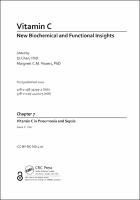Chapter 7 Vitamin C in Pneumonia and Sepsis
Proposal review
Abstract
In humans, ascorbic acid is an essential vitamin, anti-oxidant and co-factor of a variety of metal ion-dependent enzymatic reactions. In this review, the transport of L-ascorbic acid is described from food to target cells. Transport of ascorbic acid across the plasma membrane is facilitated by members of the SLC23 family, SLC23A1/SVCT1 and SLC23A2/SVCT2. We present in silico models of these transporters that provide new insights into the structure of the SLC23 family. While SVCT1 is mainly responsible for uptake of ascorbic acid from the intestine into the blood and for reabsorption in the kidney, the more broadly expressed transporter SVCT2 delivers ascorbic acid into tissues that are in high demand of the vitamin. The oxidized form of ascorbic acid, dehydroascorbic acid (DHA), is a substrate of the GLUT transporters belonging to the SLC2 family. They play important roles in ascorbic acid recycling, such as in the brain and in erythrocytes. Ascorbic acid serves as an essential co-factor of metal ion-dependent enzymes, keeping their metal ions in the reduced state. In addition, it serves as an effective antioxidant in cells with high metabolic activity such as neurons. Thus, it is not too surprising that changes in expression and function of the SVCTs have nutritional and pathological consequences such as during ageing, malnutrition and chronic alcohol abuse or in cancer, neurodegenerative diseases and chronic inflammation diseases. In the future, SVCT1 and SVCT2 may furthermore prove useful as drug delivery systems, to enhance transport of novel pharmaceutical agents more efficiently across the intestinal epithelium and the blood-cerebrospinal fluid barrier.
Book
Vitamin CKeywords
antioxidants; ascorbic acid; infectious disease; intravenous ascorbateISBN
9780429442025Publisher
Taylor & FrancisPublisher website
https://taylorandfrancis.com/Publication date and place
2020Imprint
CRC PressClassification
Pharmacology
Molecular biology
Biology, life sciences


 Download
Download